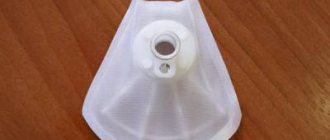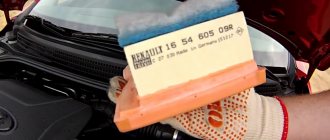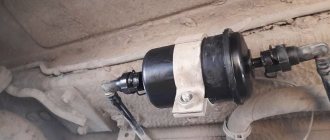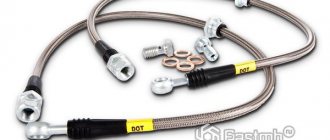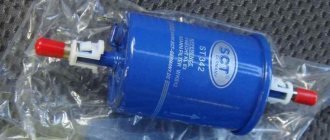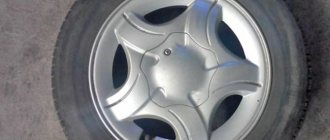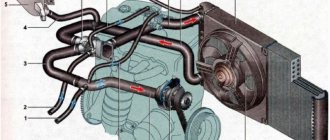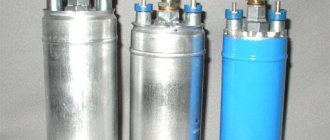Unfortunately, there is no need to talk about the high quality of fuel sold at our gas stations. The fuel contains a large number of different impurities, including small particles of dirt. If the car did not have special devices, engine overhaul would become commonplace. To clean fuel, a car has a special device - a fuel filter.
The mistake of beginners is that they consider this knot to be almost eternal. In this case, the filter element is replaced rarely or not at all. But a contaminated component is dangerous for a car - it harms the engine, since these particles are an abrasive, and when they get into the engine, they settle in the combustion chamber and do not completely burn when ignited, this has a very detrimental effect on the combustion chamber and all engine components. This is why replacing the fuel filter is so important, and this work should be done on time.
The problem is that many car owners don't know how to access the device and replace it. In fact, there is nothing complicated here - all the work can be done with your own hands and without visiting a service station. The main thing is to study the instructions, decide on the location of the unit and prepare the tool.
Location of the fuel filter and when to replace it?
On modern cars, the filter is located near the fuel tank. It is fixed using fastening clamps. Replacement of the fuel filter, according to the vehicle operating instructions, should be carried out at intervals of 30 thousand. But practical application experience shows different figures. Due to the low quality of gasoline, replacement should be carried out every 13-15 thousand mileage.
Signs of a faulty fuel filter.
- The car jerks when the speed increases. If nothing is done, jerking will be clearly noticeable at low speeds.
- Difficulty starting the engine and reducing its power.
- The car stalls on its own at idle.
- Increased fuel consumption.
- Unstable engine operation.
Please note that a clogged filter element leads to many problems. In addition to the signs already listed, there is a noticeable drop in engine power. If you have these symptoms, then change the fuel filter; you can do this in the garage with your own hands if you have a pit.
Selecting new filter elements
There are many modifications of fuel filters for Lada Kalina. Each brand offers its own system and device.
Comparison of filters from different brands
Among the popular store offerings, there are certain brands that are trusted by customers.
- Kolbenschmidt is a German company that manufactures fuel filtration systems for cars and light equipment. Expensive devices work well for their price and last longer than factory ones.
- Mann - the next German manufacturer is trusted among motorists in the European part of the country. Quite expensive consumables fully justify their price, providing high-quality fuel filtration. The company's product range includes many modifications of filters for different machines and stationary units.
- Salut - a domestic brand supplies filters to the Lada conveyor. Consequently, the car manufacturer recommends the Salyut elements. Among car enthusiasts, the brand is not trusted, which provokes a quick replacement of equipment. The main advantage of the stock version is its reasonable price.
- Bosch - Bosch filters are often bought in sets of 2-3 pieces, with a reserve. Quite expensive equipment filters fuel efficiently and is capable of working with heavily contaminated gasoline. The only caveat is the relatively short service life.
Cleaning the fuel pump mesh.
The filter element maintenance process takes place in two stages. First, remove the fuel pump. Here's the algorithm:
- Remove the black rubber band (mounted on the fuel pump grid).
- Lift the sofa for passengers to get to the lid (it is under it that the device we are interested in is located). Tighten two pairs of bolts.
- Clean the surface from dirt (a damp cloth will do). This work must be done, otherwise there is a high risk of foreign elements (like dirt) getting inside the tank.
- Remove the fuel pipes connected to the product. This is not difficult to do - take a screwdriver and use it to press on the special fastener, and pry up the tube with your other hand. After completing these steps, tighten the supply hose.
- Clean the fuel pump from dirt.
- Unscrew and move the locking ring to the side. It is easily recognized by its “golden” color. You may not be able to twist the ring the first time - here you often have to use an additional tool (screwdriver, hammer) for “help”.
- Get the fuel pump. Immediately before installation, place a rag to prevent fuel from spilling onto half of the interior.
- Before changing the fuel filter on your Lada Kalina, disassemble and clean the fuel pump:
- Discard the wires that connect to the device, as well as the sensor that controls the volume of fuel in the tank. Now remove the intake tube by picking it up with something sharp.
- Remove two pairs of clamps, and then remove the “glass” from below.
- Remove the mesh element (provides rough cleaning). Don't be alarmed if it is very dirty - this is normal.
- Clean the glass, and do the same work in relation to the rest of the fuel pump components. Next, wash the sensor in solvent.
- Assemble the fuel pump using the reverse algorithm. In this case, replace the old mesh with a new one and return it to the tank.
How to change the fuel filter
Once the fuel pump is cleaned and the dirty screen is replaced, change the filter itself. It was mentioned above that this unit is located near the rear axle wheel (on the right). Replacing the fuel filter is done as follows:
- Drive the vehicle onto an overpass or pit.
- Remove the fuse that powers the device, start the engine and wait until the remaining fuel in the system is exhausted.
- Discard all the tubes that go to it from the fuel pump (first of all, this is required for convenience).
- Press down on the fasteners and use a ten key to remove the assembly from the clamps.
- Place the newly purchased filter in the mount. At the same time, be careful during the installation process - the location of the device must be correct. When installed correctly, the arrow on the casing points towards the motor.
- Replace the fuel supply hoses.
Recommendations for self-diagnosis of the fuel cell on a Lada Kalina car
Regardless of the modification, on the Lada Kalina 1, Lada Kalina 2 in the sedan and station wagon body variations, the diagnostic process is identical.
At the initial stage, you need to make sure that there is fuel in the tank, that the fuses of the mounting block are working properly, and that the fuel supply line is intact.
To do this you need:
- Turn off the engine, open the hood.
- Inspect the fuel circuit, eliminate defects, flaws, and mechanical damage.
- Inside the car, in the lower part of the central channel, check the serviceability of two fuses (No. 12, 14).
- Place the vehicle over the inspection hole, check the tightness of the circuit, and eliminate fuel leakage.
At the second stage, we proceed to the direct inspection of the TF. To do this, remove the fuse (central channel) from its seat for 5 seconds. The so-called pressure release in the system.
Next, remove the rear seat, unscrew the diagnostic hatch cover, and remove the fuel pump with strainer. We clean the equipment and install it in its original place.
If after the work the engine has not recovered, then replace the fuel filter with a new one. We'll look at how to do it yourself on a Lada Kalina below.
Let's summarize.
- It is necessary to change the mesh on the fuel pump when installing (repairing) the fuel filter.
- Fill your tank only with high-quality fuel from reliable gas stations.
- Buy original spare parts from trusted manufacturers.
And most importantly, do not delay replacing a dirty filter. Otherwise, there is a high risk of serious consequences for the car.
Did you like the article? Follow our channel for new ideas of useful car tips. Subscribe to us in Yandex.Zen. Subscribe.
The main task of a fuel filter device is to clean the fuel from unnecessary particles that have entered it. The presence of water in the fuel system causes rusting of the injectors, leads to the development of corrosion, and this leads to engine dysfunction and clogs the fuel system. This element of the car helps clean low-quality fuel from particles of resins and all kinds of additives that are added to fuel by unscrupulous manufacturers.
The fuel filter can become dirty as a result of:
- accumulation of dust and dirt due to a possible chemical combination of gasoline with air and metal;
- corrosion caused by water condensation;
- accumulation of tarry sediment;
- clogging of fuel equipment pipes with frozen water crystals at low temperatures.
- using low quality fuel.
Causes of filter clogging
A clogged fuel filter is a consequence of contamination. Drivers who have just bought their first used car, as a rule, become victims of a clogged fuel filter.
Important! When buying a used car, you must take into account the fact that the previous car owner may not have taken care of replacing consumables when required. There is also a big question about the quality of the fuel that was poured into the car’s engine. Be aware that if you frequently refuel your car at unfamiliar gas stations, consumables will require more frequent replacement.
Only large businessmen sell fuel, because this is a product that requires a high return on investment, so it is supplied only by trusted sellers. Small gas stations often contain all sorts of additives or even resins in the fuel, which the fuel filter removes in order to extend the life of the injectors and not clog the smallest parts. For a used car this is not a big deal. In this case, you can safely take on the job of replacing the device. Replacing consumables by a novice car enthusiast is a dangerous thing. There are certain risks here.
Changing the filter on carburetor engines
If the engine has a carburetor injection system, the fuel filter is located in the engine compartment. It looks like a plastic or metal part with two tubes going towards the tank and to the engine or fuel pump. There is no point in cleaning the fuel filter at all. On your own, you will not be able to properly clean the smallest honeycombs that are contaminated by debris that has fallen into them.
To change the filter, first loosen the clamps on both sides, and then remove the tubes to release the filter. Instead of the old device, a new one is installed, adhering to the direction of fuel flow there (focus on the arrow). Then you should install the tubes and install the clamps back, checking that they are well seated. At the end, we turn on the ignition and start the engine to check the tightness of the connections we have installed.
Hello, dear friends! How nice it is to see you here and understand that we are not working in vain, you like our articles. It’s especially nice to read the comments and answer your questions.
Today I propose to continue the topic of consumables and talk about the fuel filter. Many people underestimate the importance of this device, but in vain. The performance, serviceability and technical characteristics of the car largely depend on it.
The device can be located on the fuel line between the tank and the pump, or it can be of a submersible type - this is a fuel tank filter. In general, you should understand that gasoline is not the cleanest substance. An ordinary mesh through which the fuel is poured cannot collect all the debris, but is intended only for large particles.
Selecting new filter elements
To purchase fuel purification system parts for VAZ 1117-19 models, you need to know what they look like:
- The coarse filter is a flat mesh bag made of chemically resistant plastic that captures large particles of 80-100 microns.
In the center of the element there is a plastic fitting that fits onto the counterpart of the gasoline pump. The mesh element is equipped with a pipe that fits onto the fuel pump fitting - The fine filter is made in the form of a cylinder with two fittings at the ends.
The body is made of metal or special plastic - polyamide, and there is filter paper inside it. It traps particles measuring 15-50 microns. The pipes are equipped with clamps for fastening fuel hoses. The element is equipped with clamps for fastening fuel line connections
There are no tricks in choosing a coarse mesh - the parts are made according to a single sample and cost from 30 to 45 rubles. The only caution: in order not to purchase a low-quality product or a fake, contact well-established stores. Although the fuel pump mesh costs a penny, it plays an important role in the fuel system: it catches large debris that can quickly clog the filter paper of the next cleaning element.
In operation, the plastic case is not inferior to the metal one in terms of reliability.
The material from which secondary filters are made does not play a big role
What is important is the contents of the “barrel”, which cannot be seen or touched. Therefore, there are only 3 selection criteria:
- correspondence between the body dimensions and the diameter of the fittings;
- the presence of plastic clamps;
- brand (manufacturer).
The mounting clamp on the Kalina is designed for a case diameter of 56 mm
There are many different fuel filters sold in stores, and not all of them are equipped with clamps (in other cars, the hoses can be secured with clamps). The part for “Kalina” must have latches, otherwise the tubes cannot be secured.
A plastic latch secures the hose to the filter fitting
In the countries of the former USSR, the following manufacturers of gasoline filters have proven themselves best:
- BOSCH;
- FRAM;
- FILTRON;
- SCT Germany;
- UFI.
At the moment, second-generation Kalina machines are equipped with fine filters made of polyamide. But users are not very complimentary about the factory spare parts: after disassembly, it was discovered that the paper “accordion” was poorly glued to the body. As a result, half of the fuel passed through the gas pipeline without filtering. At the same time, based on the practice of isolated cases, it cannot be unequivocally stated that metal filters are better than plastic ones.
Inside the filter element there is porous paper that traps small particles
Table: cost of VAZ 1118 filters
| Brand name | BOSCH | FRAM | FILTRON | SCT Germany | UFI | MANN |
| Price in rubles as of autumn 2022 | 390 | 340 | 335 | 230 | 280 | 410 |
Why is it needed?
There is a coarse filter that comes first from the gas tank. After all, first the lid where the fuel tank is located is opened, a gun is inserted there, the magic button is pressed and the fuel flows. Yes, it takes a lot of your money along the way, but what can you do? The location of the tank can be on the left or right, but this does not play a special role. Coarse cleaning, which is a mesh that traps large particles of debris.
This is followed by a fine filter. This is exactly what we will talk about. This element is called a fuel filter. With its help, small particles are retained. But even they can penetrate your diesel engine or gasoline injector.
Dust, dirt, debris, rust elements. All this can penetrate the system, causing a clogged pipe, tube, valve, fuel hose, or fuel pump components. Nothing good will come of this if timely replacement is not made.
To understand how to replace the filter, which element to choose and how to choose an analogue for the device you are going to change, you need to have at least a basic understanding of such an important component of the car.
I suggest starting with varieties.
Modern fuel filters installed on Ford Focus, Nissan Almera, Hyundai Solaris, Nexia, Mazda, Opel, BMW e60, Renault Logan and Megane, Kia Rio and many others have at least two degrees of purification.
- First degree. This is a rough cleansing that allows you to get rid of large contaminants. Not to be confused with a regular mesh in the tank, which is not available everywhere.
- Second degree. Fine cleaning. This is the main task that falls on the shoulders of the filter.
And here you probably have the main question - where is the filter device located? I don't know. No, I can answer, but if you tell me specifically what make of your car or what year of manufacture. After all, on the same Chevrolet Niva, different Opel, Toyota, Mazda models, on the Volkswagen Passat B3, as well as on the domestic VAZ 2114, 2112 and 2110, the location may differ.
However, they are always located somewhere between the engine and the gas tank, since the filter's job is to prevent contaminants from entering the engine while the fuel moves from the tank to the engine. What's in the gas tank itself? That's right, a coarse cleaning device. This is an additional filter element so that any unscrupulous gas stations do not spoil your car.
Now let’s talk about the types of filters themselves. What element will be on the car? It depends on the type of engine. There are three of them, as you know. Except for electric motors. Well, there is no need for a fuel filter, as you understand.
Therefore, there are three types of filters:
Location
So you bought yourself a brand new sedan and you think it’s time to change the filter for this engine. Want to choose the best? Well then, take a closer look at Cummins devices. Mann, Hertz. They have proven themselves well, and they cost quite a bit.
You probably know whether your engine is diesel, injection or carburetor. This is important to understand the location of the fine filter, that is, our today's hero.
- Carburetor. In these engines, the TF (fuel filter) is placed in front of the carburetor itself, and is often in a transparent housing to control contamination. These are the most basic devices, because the carburetor is the least demanding on the quality of fuel.
- Injector. It uses nozzles and therefore requires high-quality filtration. And the fuel is supplied under high pressure. Therefore, the filters are enclosed in durable metal housings. The TF has to be regularly maintained, cleaned and monitored for its condition. They are placed mainly under the bottom of the car to make it easier to dismantle and replace.
- Diesel. A diesel engine also needs high-quality purified fuel, since the system is quite sensitive. Diesel fuel has a higher moisture content than gasoline. The TF is designed to filter debris and remove accumulated moisture. A separator is provided for this purpose. The location is quite simple - between the engine and the pump that pumps fuel.
Any fuel system must include a TF. They are replaced assembled, that is, there is no point in removing the filter elements themselves (usually special paper), leaving plastic or metal. Be sure to look at the number and article number of the filter that is installed on your machine, and check the operating manual from the factory. This is the only source of truthful information regarding the maintenance of your particular vehicle in this configuration and with this type of engine.
avtoexperts.ru
This article is simultaneously relevant for the following VAZ models: 2108i, 2109i, 21099i, 2114i, 2115i, 2110, 2112, 2111, Kalina, Priora. On each of these models there are two fuel filters, one for coarse cleaning (fuel pump mesh) located in the fuel module . Another fine filter is located under the car between the gas tank and the spare wheel niche (trough).
Before replacing filters, you first need to relieve the pressure in the system. There are several ways to do this. The first is to remove the fuel pump fuse (f1), located in the fuse box behind the center console.
To access it, you need to unscrew several screws securing the cover at the passenger's feet.
On Kalina, the fuse for the fuel pump is located under a plastic cover in the center console.
Or disconnect the fuel pump power supply, having first unscrewed the screws securing the hatch to access the fuel pump under the rear seat.
After this, start the car, and when it stalls, turn the starter a little.
A simpler option for relieving pressure would be to remove the protective cap from the end of the fuel rail and press the spool. It is better to place some small container under it, because... A small amount of gasoline will leak out.
The coarse filter (fuel pump mesh) is changed as needed, the fine filter every 30,000 miles.
To replace the coarse filter, you will need to unscrew the fuel pipes coming to the pump, and then unscrew the pump mounting nuts (head 10) and remove the pump from the tank. Remove the plastic flask at the bottom of the pump and remove the screen by moving downwards.
To replace the fine filter, you will need to unscrew the nut securing the filter to the car body, and then disconnect the fuel pipes from the filter.
There are two types of fastening of fuel pipes to the filter: classic threaded and snap-on. The first option will need to be unscrewed using two keys, one holding the nut on the filter, the other tightening the fuel pipe nut.
The second option simply snaps off by pressing the bracket.
Don't forget about the rubber O-rings at the ends of the fuel pipes. It would be better to buy at least 4 pieces in advance, and even better, instead of rubber rings, use copper washers.
Assembly is carried out in reverse order.
A coarse filter (fuel pump mesh) and a fine filter depend on the engine size. For the 1.5 engine there is a coarse filter with article number 2112-1139200, for 1.6 there is a filter with article number 1118-1139010. The fine filter for 1.5 (before 2005-2006 onwards) comes with threaded connections, for 1.6 (after 2005 onwards) with fittings for latches, but before replacing it is better to separately look at the connections of the fuel pipes to the filter. The catalog number of the original filter on nut connections is 2112-1117010-82, and the filter on snap connections is 2123-1117010-82
When is it time to change
You can buy yourself a new TF literally as soon as you purchased the car from the showroom or took it from your hands. But after how long can it or should it be changed?
If you change the TF on a used car as soon as you re-register it, nothing bad will happen. It is not known what kind of filter was there before and how many kilometers it has already traveled and how long ago the previous owner changed it.
The frequency of TF replacement can vary significantly depending on a number of factors:
- vehicle condition;
- driving style;
- terms of Use;
- fuel system operation;
- the quality of repairs performed regarding the engine and fuel system;
- the quality of the gas stations where the previous owner of the used car refueled;
- engine's type;
- motor power, etc.
Only the specific instruction manual can answer you. And how often the TF changes depends on you specifically.
In general, I’ll tell you, many people believe that on diesel cars the TF is changed every 30 thousand kilometers, and on gasoline cars - from 60 to 100 thousand kilometers. And some automakers even say that the filter installed from the factory will last as long as the car itself.
Alas, these numbers are far from the truth. Why? It's simple. Ideal operating conditions are taken into account here. That is, smooth roads, high-quality fuel, measured driving style, and so on. Which of these do you have? Personally, I have problems on all counts, since driving on our roads in this way is impossible, even with a strong desire.
Therefore, the reality is that diesel filters are changed every 10-30 thousand kilometers, and gasoline filters - 20-60 thousand. Yes, there are exceptions when the car is rarely used, the driver is extremely careful and refuels at the best gas stations. Here the filter can really last 50-100, or even more than thousands of kilometers.
I will give one piece of advice that is far from bad. Take into account the mileage and compare it with the operating conditions of the vehicle. This way you will understand exactly how often you should change the TF.
A car is such an advanced invention that it itself will show signs indicating the need for replacement.
